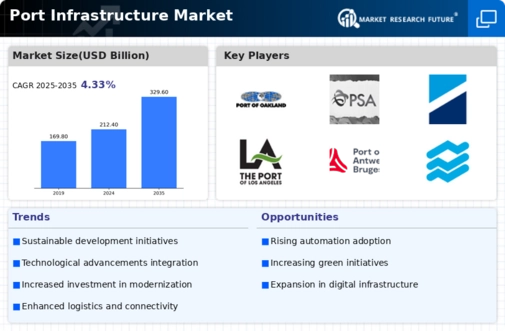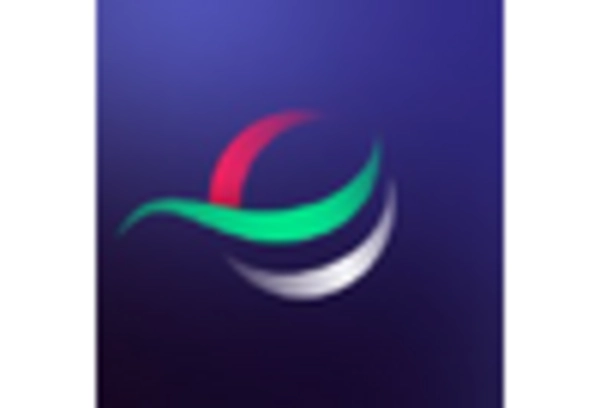Increasing Trade Volumes
The Port Infrastructure Market is experiencing a notable surge in trade volumes, driven by the expansion of international trade agreements and the growing demand for goods. As economies recover and develop, the need for efficient port facilities becomes paramount. In 2025, it is estimated that global trade volumes will reach unprecedented levels, necessitating enhanced port capacities and modernized infrastructure. This trend indicates that ports must adapt to accommodate larger vessels and increased cargo throughput. Consequently, investments in port infrastructure are likely to rise, as stakeholders recognize the importance of maintaining competitive advantages in a rapidly evolving market. The integration of advanced technologies, such as automation and data analytics, further supports this growth, allowing ports to optimize operations and improve service delivery.
Technological Advancements
Technological advancements are reshaping the Port Infrastructure Market, as innovations in logistics and supply chain management become increasingly critical. The adoption of automation, artificial intelligence, and Internet of Things (IoT) technologies is transforming port operations, enhancing efficiency and reducing operational costs. In 2025, it is anticipated that ports implementing these technologies will experience improved cargo handling times and reduced turnaround periods for vessels. This shift not only boosts productivity but also enhances the overall competitiveness of ports in the global market. Moreover, the integration of smart technologies allows for better data management and real-time tracking of shipments, which is essential for meeting the demands of modern trade. As a result, stakeholders in the Port Infrastructure Market are likely to prioritize investments in technological solutions to remain relevant and efficient.
Urbanization and Population Growth
Urbanization and population growth are pivotal factors influencing the Port Infrastructure Market. As urban centers expand, the demand for imported goods increases, placing additional pressure on port facilities. By 2025, urban populations are projected to rise significantly, leading to heightened logistical challenges. Ports must therefore enhance their infrastructure to manage the influx of goods efficiently. This scenario suggests that investments in port facilities will be essential to support urban development and ensure the timely delivery of products. Furthermore, the need for sustainable practices in port operations is becoming increasingly apparent, as urban areas seek to minimize environmental impacts. The Port Infrastructure Market must adapt to these changing dynamics, focusing on innovative solutions that align with urban growth while addressing sustainability concerns.
Environmental Regulations and Sustainability
The Port Infrastructure Market is increasingly influenced by stringent environmental regulations and a growing emphasis on sustainability. As governments and organizations commit to reducing carbon emissions and promoting eco-friendly practices, ports are compelled to adapt their operations accordingly. By 2025, it is expected that compliance with environmental standards will drive significant investments in green technologies and sustainable infrastructure. This trend suggests that ports will need to implement measures such as renewable energy sources, waste management systems, and eco-efficient cargo handling processes. The shift towards sustainability not only addresses regulatory requirements but also enhances the reputation of ports, attracting environmentally conscious stakeholders. Consequently, the Port Infrastructure Market is likely to witness a transformation as it aligns with global sustainability goals, fostering a more responsible approach to port operations.
Public Investment and Infrastructure Development
Public investment in infrastructure development is a crucial driver for the Port Infrastructure Market. Governments worldwide are recognizing the importance of modernizing port facilities to support economic growth and enhance trade competitiveness. In 2025, it is anticipated that public funding for port infrastructure projects will increase, driven by the need for improved logistics and transportation networks. This investment is likely to focus on expanding port capacities, upgrading existing facilities, and enhancing connectivity with inland transportation systems. Furthermore, public-private partnerships are expected to play a vital role in financing these initiatives, allowing for shared resources and expertise. As a result, the Port Infrastructure Market stands to benefit from increased public investment, which will facilitate the development of state-of-the-art port facilities capable of meeting future demands.


















Leave a Comment